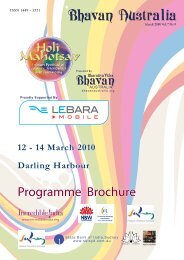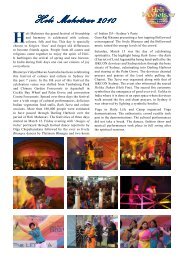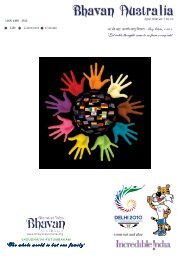Issue 8.5 - Bharatiya Vidya Bhavan Australia
Issue 8.5 - Bharatiya Vidya Bhavan Australia
Issue 8.5 - Bharatiya Vidya Bhavan Australia
You also want an ePaper? Increase the reach of your titles
YUMPU automatically turns print PDFs into web optimized ePapers that Google loves.
Annaprasan<br />
Annaprasan literally is ‘putting solid food or rice<br />
into a child’s mouth for the first time’. Anna means<br />
‘food’, especially ‘boiled rice’. Prashana means<br />
‘eating, feeding’, and specifically ‘the first feeding of<br />
a child’. The ceremony ritualizes the start of a<br />
nursing child’s additional solid nourishment from<br />
the age of six or seven months. This Sanskara<br />
developed out of the physical need of the child for<br />
more nourishment. It also established a point in the<br />
child’s development at which the mother should<br />
consider beginning to wean him.<br />
The Ceremony<br />
After a Muhurta has been selected for the<br />
ceremony, friends and relatives are invited. Food is<br />
cooked to the chanting of appropriate Vedic<br />
mantras. The father feeds the child as the priest<br />
recites the Mahavyahritis. The child is then placed<br />
on kusha grass before the fire. Next, the father<br />
offers oblations to Agni praying that the child<br />
should be strong and well spoken. He also prays for<br />
a long, happy and contented life, for fame, and for a<br />
broad vision for the child.<br />
After this, according to the Markandeya Purana, the<br />
child is placed amongst tools and articles used in<br />
various crafts and occupations. It is believed that<br />
16 | <strong>Bhavan</strong> <strong>Australia</strong> | Nov 2010<br />
the article that he touches first decides his future<br />
occupation. When this has been done, the<br />
Brahmins invited for the occasion and relatives are<br />
fed food specially cooked for the occasion. The<br />
Brahmins are also given gifts.<br />
Grihyasutras<br />
According to the Grihyasutras, Annaprashana<br />
should be performed when the child is between six<br />
and seven months old. For a weak child, it can be<br />
postponed further. However it should not be<br />
performed before the child is four months old<br />
because he will not be able to digest food before<br />
then. Nor should the ceremony be performed after<br />
he is a year old because delaying additional<br />
nourishment could retard the child’s natural<br />
growth and development. Some people believe that<br />
it should be performed after the child’s first teeth<br />
come out as this is a sure sign that he will be able<br />
to digest solid food.<br />
Sushruta<br />
According to Sushruta, the food given to the child<br />
during Annaprashana should be easy to digest. He<br />
should be fed different foods with different flavours.<br />
A mixture of honey, yogurt, and ghee or meat is<br />
offered to the child. The meat of every animal and<br />
bird is believed to have a different quality,<br />
which is imparted to the child. Like, fish<br />
is believed to give swiftness. The<br />
Markandeya Purana recommends<br />
milk, rice, ghee and honey.<br />
The concept of Annaprashana<br />
existed among the Aryans<br />
before they came to India.<br />
This view is supported by<br />
the presence of a similar<br />
ceremony among the<br />
Parsis. It became a<br />
religious ritual by the time<br />
of the Sutras.<br />
Source: www.gurjari.net









